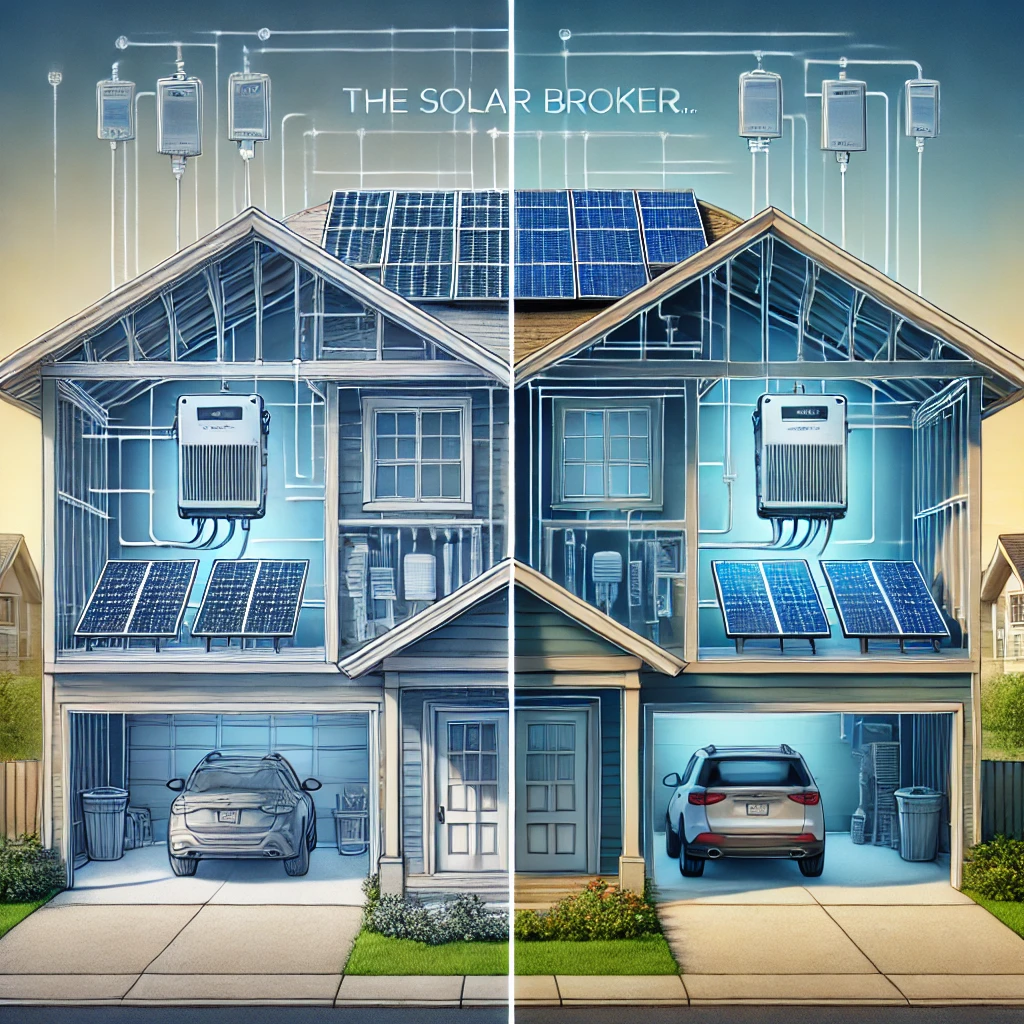
When deciding to install a solar energy system for your home, one of the most important decisions you’ll make is choosing the right type of inverter. Inverters are the backbone of any solar installation, converting the direct current (DC) electricity generated by your solar panels into usable alternating current (AC) electricity for your home. The two main types of inverters available to homeowners are microinverters and string inverters, each offering distinct advantages and trade-offs.
In this post, we’ll break down the key differences between microinverters and string inverters to help you determine which option is best for your solar system.
What Are String Inverters?
String inverters are the traditional type of inverter used in most residential solar installations. In a string inverter system, multiple solar panels are connected in series, forming a “string,” which sends the combined power to a single central inverter. The string inverter then converts the DC electricity from all the panels into AC electricity for your home.
Advantages of String Inverters:
• Cost-Effective: String inverters are typically more affordable than microinverters, making them a popular choice for homeowners looking to keep costs down.
• Proven Technology: String inverters have been around for a long time and are reliable, with well-established performance standards.
• Simpler Design: With fewer components to install, string inverters make for a simpler installation process, which can reduce labor costs.
Disadvantages of String Inverters:
• Performance Impact from Shading: Because all the panels are connected in series, if one panel is shaded or experiences reduced performance, it can lower the output of the entire system.
• Single Point of Failure: If the string inverter fails, the entire system stops working until it is repaired or replaced.
• Limited Optimization: String inverters don’t allow for individual panel optimization, meaning underperforming panels can drag down the overall efficiency of the system.
What Are Microinverters?
Microinverters take a different approach by placing a small inverter on each individual solar panel, rather than using one central inverter. This allows each panel to convert its own DC electricity into AC electricity independently of the others.
Advantages of Microinverters:
• Panel-Level Optimization: With microinverters, each solar panel operates independently. This means if one panel is shaded or underperforming, it doesn’t affect the output of the other panels, leading to higher overall system efficiency.
• Better Performance in Shaded Areas: Microinverters are ideal for homes where parts of the roof may experience shading throughout the day, as they ensure that shaded panels don’t lower the output of the entire system.
• System Monitoring: Microinverters allow for more detailed system monitoring, as you can track the performance of each individual panel.
• Greater Reliability: Since each panel operates independently, a failure in one microinverter won’t affect the rest of the system. This distributed design increases reliability.
Disadvantages of Microinverters:
• Higher Cost: Microinverters are generally more expensive than string inverters, both in terms of equipment and installation.
• More Components: Because each panel has its own inverter, there are more components to install and potentially maintain, which can increase the complexity of the system.
Which Inverter Is Right for Your Home?
When deciding between microinverters and string inverters, consider the following factors:
• Shading: If your roof has areas that are shaded by trees, chimneys, or other obstructions, microinverters may be the better choice as they optimize the performance of each individual panel. For roofs with minimal shading, a string inverter can still offer excellent performance at a lower cost.
• System Size: For larger systems with many panels, the cost of microinverters can add up quickly. String inverters are often more cost-effective for large-scale installations, while microinverters shine in small to medium-sized systems.
• Budget: If your primary concern is keeping installation costs low, a string inverter may be the way to go. However, if you’re willing to invest in higher upfront costs for long-term performance gains, microinverters offer better optimization and efficiency.
• Monitoring: If you want detailed insights into how each panel is performing, microinverters provide more granular monitoring capabilities. String inverters typically only provide monitoring at the system level.
Conclusion
Both microinverters and string inverters have their advantages, and the best choice depends on your specific situation. String inverters are more cost-effective and simpler to install, making them a solid option for homes with little to no shading. On the other hand, microinverters offer better performance in shaded areas, more reliability, and greater flexibility, but at a higher cost.
At The Solar Broker, LLC, we can help you decide which inverter technology is right for your home. Whether you’re in Virginia Beach, Richmond, or anywhere in between, our team will ensure you get the most efficient and cost-effective solar system for your needs. Contact us today to get started!
Let me know if you’d like any further adjustments or additional details added!